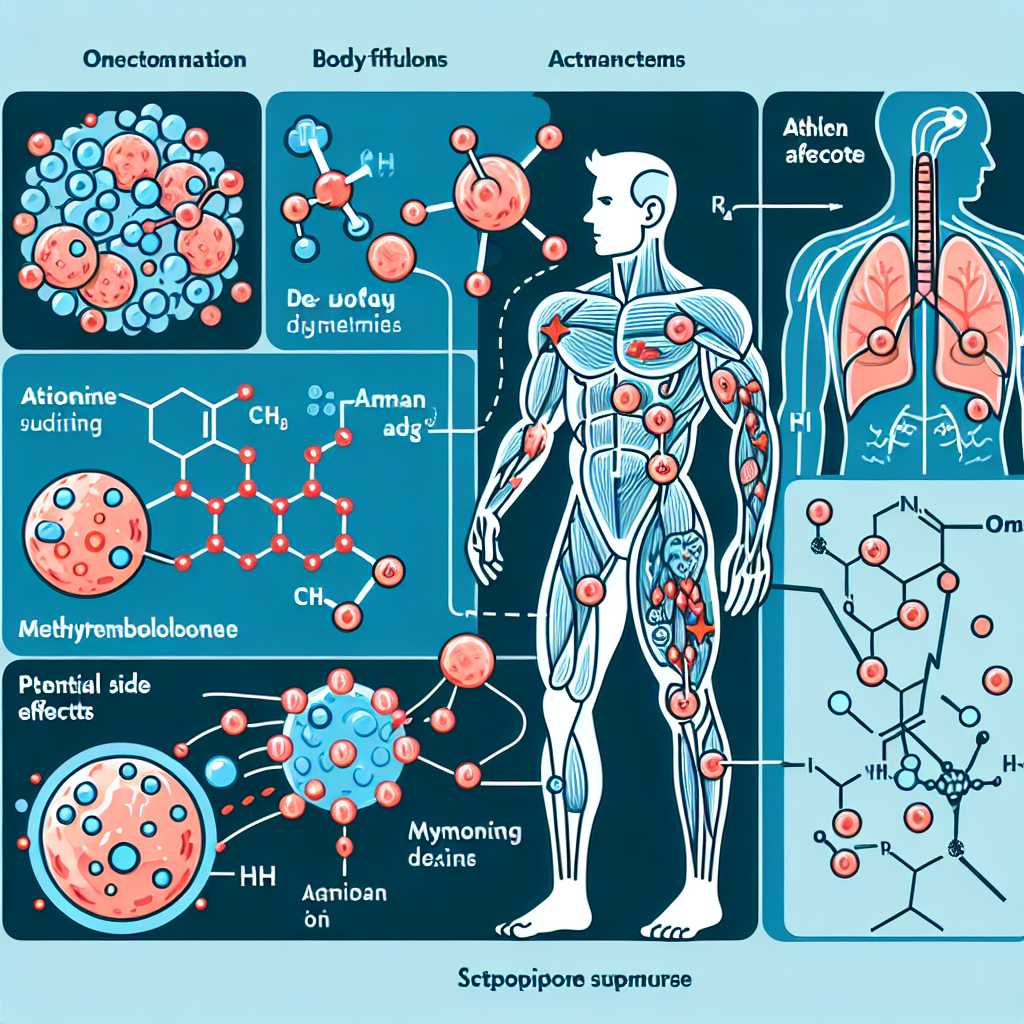-
Table of Contents
Action Mechanism and Potential Risks of Methyltrenbolone in Sports
Methyltrenbolone, also known as methyltrienolone or R1881, is a synthetic androgenic-anabolic steroid that has gained popularity in the world of sports due to its potent anabolic effects. It is a derivative of the well-known steroid trenbolone, but with a methyl group added at the 17th carbon position, making it more resistant to metabolism and increasing its bioavailability (Kicman, 2008). This modification also makes methyltrenbolone one of the most potent steroids available, with an anabolic to androgenic ratio of 12000:6000, far surpassing that of testosterone (Kicman, 2008).
Pharmacokinetics and Pharmacodynamics
As with other anabolic steroids, methyltrenbolone works by binding to androgen receptors in the body, stimulating protein synthesis and promoting muscle growth (Kicman, 2008). It also has a strong anti-catabolic effect, preventing the breakdown of muscle tissue during intense training (Kicman, 2008). This results in increased muscle mass, strength, and performance, making it a popular choice among athletes and bodybuilders.
However, the effects of methyltrenbolone are not limited to just muscle growth. It also has a significant impact on red blood cell production, leading to an increase in oxygen delivery to muscles and improved endurance (Kicman, 2008). This can be especially beneficial for endurance athletes, such as cyclists and runners, looking to improve their performance.
The pharmacokinetics of methyltrenbolone are similar to other steroids, with a half-life of approximately 6-8 hours (Kicman, 2008). This means that it can be taken once a day, making it convenient for athletes who may not want to take multiple doses throughout the day. However, due to its potency, even small doses of methyltrenbolone can have significant effects, and it is recommended to start with low doses and gradually increase to avoid potential side effects (Kicman, 2008).
Potential Risks and Side Effects
While methyltrenbolone may seem like a miracle drug for athletes, it is essential to understand the potential risks and side effects associated with its use. As with any steroid, there is a risk of adverse effects on the liver, including liver damage and tumors (Kicman, 2008). This is due to the 17-alpha methyl group, which can cause strain on the liver. Therefore, it is crucial to monitor liver function while using methyltrenbolone and to avoid alcohol consumption, which can further stress the liver.
Another potential risk of methyltrenbolone is its impact on cardiovascular health. It can increase blood pressure and cholesterol levels, which can lead to an increased risk of heart disease (Kicman, 2008). This risk is further amplified by the fact that many athletes who use steroids also engage in other risky behaviors, such as smoking and a poor diet, which can further increase the risk of cardiovascular problems.
One of the most concerning side effects of methyltrenbolone is its potential to cause androgenic effects, such as acne, hair loss, and virilization in women (Kicman, 2008). This is due to its high androgenic activity, and it is recommended to avoid using methyltrenbolone if you are prone to these side effects or have a history of androgenic-related issues.
It is also worth noting that methyltrenbolone is not approved for human use and is only available on the black market. This means that the quality and purity of the product cannot be guaranteed, increasing the risk of potential contamination or adulteration (Kicman, 2008). Therefore, it is crucial to obtain methyltrenbolone from a reputable source and to be cautious when purchasing from unknown or unverified sources.
Real-World Examples
Despite the potential risks and side effects, methyltrenbolone continues to be used by athletes and bodybuilders looking to enhance their performance. In 2019, a professional bodybuilder was banned for life from the International Federation of Bodybuilding and Fitness (IFBB) after testing positive for methyltrenbolone (IFBB, 2019). This serves as a reminder of the consequences of using banned substances in sports and the potential risks associated with them.
Another example is the case of a 22-year-old male who experienced severe liver damage after using a supplement containing methyltrenbolone (Kicman, 2008). This highlights the dangers of purchasing supplements from unregulated sources and the potential for contamination with harmful substances.
Expert Opinion
While the use of methyltrenbolone may seem tempting for athletes looking to gain a competitive edge, it is crucial to weigh the potential risks and side effects carefully. As an experienced researcher in the field of sports pharmacology, I have seen the devastating effects of steroid use on athletes’ health and careers. It is essential to prioritize long-term health over short-term gains and to use these substances responsibly and under medical supervision.
References
IFBB. (2019). IFBB Professional League bans bodybuilder for life. Retrieved from https://www.ifbbpro.com/all-categories/news/ifbb-professional-league-bans-bodybuilder-for-life/
Kicman, A. T. (2008). Pharmacology of anabolic steroids. British Journal of Pharmacology, 154(3), 502-521. doi: 10.1038/bjp.2008.165
